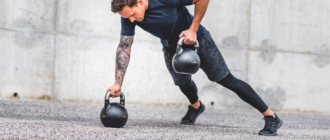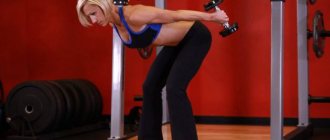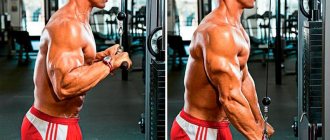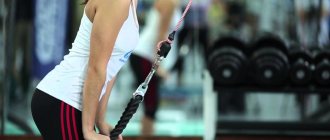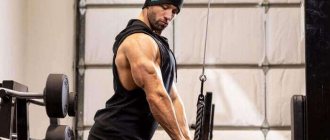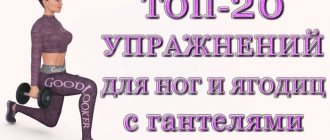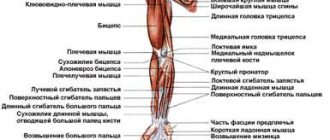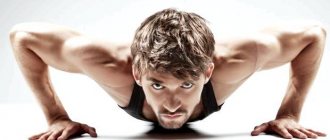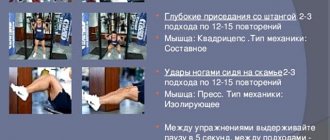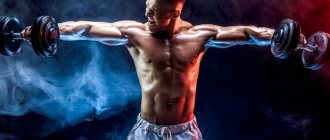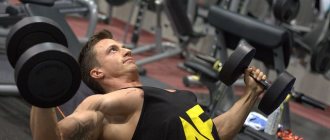This version of the triceps exercise is available to everyone. Unlike the barbell movement, the French press with dumbbells is suitable for complete beginners and those who are not comfortable performing the exercise on a straight bar. The exercise has been used in bodybuilding for a long time, and is inherently not suitable for working at the limit. The exercise is performed in a multi-repetition mode, there are variations while sitting and standing. It is used both in bodybuilding and in strength sports. Can be performed by both men and women. It is isolating in nature and develops the main pressing muscle – the triceps. The choice between the sitting and standing option also depends on the condition of the athlete’s back; for those with a back injury, the exercise option from a sitting position is recommended.
Execution technique
French press with dumbbells standing
Original
- The projectile is taken from the racks with both hands or from the floor by the discs with a locking grip;
- By bending the knee and hip joints, the dumbbell is removed from the floor or racks and thrown back to its original position in one movement;
- The elbows are “in” at the top, the arms are fully straightened;
- The shoulder blades are brought together, the back is slightly arched and tense;
- The abdomen is retracted, the spine is in the anatomically correct position for it, there is no need to bend in the thoracic or lumbar region
Movement:
- Bend your knees slightly to soften your stance;
- Bend your arms at the elbow joints and smoothly lower the dumbbell behind your back;
- Exhale and straighten your arms at the elbow joints, smoothly squeezing the dumbbells upward;
- Do not change the position of your hands on the bar during the exercise.
It's the FRENCH DUMBBELL PRESS, baby.
Seated French press with dumbbells
This exercise can be performed sitting on a dumbbell bench with a backrest, or on a Scott bench, with your back to the biceps racks:
- Take the starting position, dumbbell bar between your thumbs, hands intertwined on the discs;
- Bend your elbows and lower the dumbbell behind your back;
- Extend your arms smoothly, squeezing the dumbbell to the starting position;
- Perform the required number of repetitions as planned
Attention
- The bench press is performed without bending the lower back. It can only be small, determined anatomically; the “bridge” movement should not be performed;
- Elbows should not be spread, forearms should be parallel to each other;
- Shoulders should not rise up or move forward and sideways when performing presses;
- Triceps work better if the position is vertical
Recommendations
- There is no need to “stuff” your neck with a dumbbell. If the discs touch the vertebrae, you should choose a narrower apparatus, or refuse to perform this movement variation and do the exercise in the “one-armed” version;
- The dumbbell cannot be “dropped” down or pushed below the amplitude that is permissible with the natural movement of the arms. Athletes with large biceps should not “clamp” their arms so much that it becomes uncomfortable;
- It is not recommended to work in the upper third of the amplitude, in order to avoid overstretching the elbow ligaments; it is better to perform the movement completely, but use less weight on the projectile than partially, but constantly;
- The bar should fit between your index fingers and thumbs. The grip, when each hand takes the disc separately, is not entirely comfortable and is not anatomically the most advantageous;
- A belayer is necessary not only for heavy lifters, but also for beginners who may not feel very confident.
French press with dumbbells standing and sitting: execution technique
Bench press
This exercise is performed while sitting on a bench. This position perfectly unloads the back. If necessary, replace the EZ dumbbell with a bar.
Algorithm of actions:
- grab the projectile with both hands, wrap your thumb around the bar;
- sit on the bench;
- the dumbbell shoots up;
- the arms are bent at the elbows, the projectile is moved behind the head;
- stretch the muscle fascia, then return to the original position;
- repeat the approach as much as the program requires.
Important! There is also an option without dumbbells. But it is suitable only for people who have reached at least an average level in bodybuilding.
Variations of the exercise
The movement can be adapted to almost any anatomical feature, be it broad shoulders, large hands, insufficient flexibility of the shoulder joint, and the inability to connect the hands on dumbbell discs.
French press sitting or standing with two dumbbells
This option is indicated for those who experience discomfort when performing movements on the bar and cannot hold the weight behind their head or bend both arms at the same time due to the large volume of muscles. This option is also suitable for those whose triceps are developed differently, and one hand takes on the entire load.
The exercise technically replicates the single dumbbell variations, but you need to hold two dumbbells and perform the movement in sync.
Some people recommend holding the dumbbells together, but this is not suitable if the reason for choosing this option is a shoulder injury. In this case, the forearms are held parallel to each other.
One-arm overhead extension
This option is better suited for those who experience discomfort and are faced with different development of both halves of the body. Those who have one triceps weaker than the other usually perform “one-armed” versions of exercises simply because this allows them to achieve harmonious development. This extension variation is widely used in bodybuilding. You can also perform the exercise by holding one forearm with the opposite hand.
Technically, the movement has its own characteristics - you can bend your arm so that the forearm is perpendicular to the spine, or parallel, but then the shoulder is held with the help of the second hand. Otherwise, the movement resembles the version with one dumbbell - flexion and extension at the elbow joint.
The most important point in all technical variations of the exercise is keeping the elbow and forearm in the same position. If the elbow moves along a trajectory and plane, the athlete performs the exercise incorrectly and takes some of the load off the triceps. Shoulder movement is also not allowed. The elbows should be fixed at one point throughout the exercise. If you can’t hold them, you should consider doing the exercise with a rope handle, either with your forearm secured against the wall, or with your free hand.
Important Tips
To achieve maximum effect, be sure to consider the following points:
- During the exercise, concentrate only on the movement of the forearm. Shoulders and elbows should remain stationary.
- It is recommended to lower the dumbbell slowly in order to fully feel the muscle stretch.
- At the bottom, always pause briefly for up to two seconds.
- If the dumbbell has a lot of weight, then you should throw it very carefully so as not to damage the joints.
- Do triceps exercises with a spotter . This will help you concentrate and make the most of the last few reps. They are the ones who perfectly load the muscles and give results. As Stuart McRobert says, it's easy to get off track at the end of a set. That's why an assistant is needed.
- If after training your arms are very sore and cannot be straightened, be sure to find out the reason, it could be an injury.
Analysis of the exercise
Anatomy of exercise: which muscles work
- The main movers are the triceps, especially the long and lateral heads. In this exercise, the muscles carry out their main work - they extend the shoulder, working through the elbow joint, there are no anatomically unnatural angles.
- Accessory muscles are all core stabilizers from the abdominals and lats, to the trapezius and core muscles, legs, and elbow muscles. The anterior deltoids, rear deltoids, and pectoralis major muscles stabilize the shoulder position.
Benefits of Exercise
- Promotes full amplitude of muscle stretching, allows for full contraction, since the stretch is full-amplitude;
- The movement helps protect your wrists from injury, since it is easier to hold a dumbbell than a barbell;
- Suitable for those who, for health reasons, cannot work with heavy weights;
- Can be used in women's training;
- Allows you to adjust not only the weight, but also the amplitude, taking into account the developmental characteristics of the athlete, the condition of his shoulders and the amplitude of elbow flexion;
- Suitable for the option with rubber shock absorbers, and weights, as well as sandbags, if dumbbells are not at hand;
- Suitable for those who, due to their large biceps, cannot bench press the barbell in this exercise.
Minuses
- Cannot be used by athletes who, due to the development of the shoulder joint, cannot place their hand behind their ear;
- Should not be used by those who experience pain in the elbows, at least until they see a doctor and get a diagnosis;
- With significant weight, the load falls on the long back muscle, which runs along the spine;
- The exercise cannot be used in training those people who suffer from hernias or protrusions with pain, since using significant weight can lead to even greater displacement of the vertebrae
Exercise for triceps. Arm extensions with a dumbbell.
How to replace the dumbbell overhead press
If a person has injured the rotator cuff, triceps, elbow ligaments or anterior deltoids, the exercise is removed from the training plan until complete recovery. The stretched position of the muscle does not allow the injured area to recover, so it is better to temporarily remove this movement. During the rehabilitation period, the most common choice is triceps extension with a pigtail with a very light weight.
If the grip with dumbbells is not comfortable, the “one-armed” option is uncomfortable in the shoulder, you should choose either an option with a curved bar or rubber shock absorbers of sufficient resistance. Working with rubber bands strengthens the ligaments and allows the shoulders and elbows to remain stable. Over time, it will be possible to do the exercise with dumbbells as weights.
The movement is performed in 3-4 working sets, 8-12 or more repetitions. The number of approaches and repetitions depends on the training program. Triceps are trained 1 to 2 times a week, trying not to overload them with heavy exercises if the bench press is included in the program. Perform the exercises with good technique and you will achieve your goals.
Preparing for the exercise
This movement is rarely performed at the beginning of a workout or as the only one, so warming up is usually done before starting the exercise. If for some reason the exercise comes first in the plan, you should perform 20-30 flexions-extensions in the elbow joint, and rotations in the shoulder joint.
The exercise should not be performed immediately with a working weight. It is necessary to perform 2-3 warm-up approaches if the weight is heavy, or 1-2 if not significant. “Large” is considered to be a weight close to a third of the athlete’s own body weight.
The movement is not recommended to be included in the plan if the athlete cannot safely move the forearm behind the ear.
Proper execution
- During the exercise, the elbows should not “dangle” along the trajectory or diverge to the sides. If it is uncomfortable to hold them in the desired position, and the trapezius is pulled, you should perform the exercise with two dumbbells, or with each hand in turn, with one dumbbell;
- During the exercise, the apparatus should not slide in the hands so that the athlete drops it on his back. It is better to hold the dumbbell in one position by the discs;
- There is no need to force the dumbbell to the back by contracting the biceps; the natural range of motion is sufficient;
- While gripping, your hands hold the projectile in the lock; you don’t need to hold the dumbbell overlapping your palms, as there is a greater chance that it will fall out of your hands;
- A bench with a backrest is more preferable for those who cannot control the position of their back. Ideally, the back should be high enough so that the athlete can press the back of his head against it;
- The pace of movement should be average, you should not “throw” the dumbbell down and actively “push” it up with your hands, the pressing movement should be smooth
Errors
- The movement should not be done by pushing, it should be slow;
- Elbows do not diverge to the sides;
- The forearms do not tend to be parallel with the floor;
- The trapezius does not rise to the ears “forcibly”;
- The back is not rounded;
- In the rack, the knees do not need to be “inserted”; you should leave them inserted;
- But you should straighten your elbows completely, stay in the lower part of the amplitude and just don’t work there
Efficiency Tips
- Usually there is no point in sitting on a bench without a backrest; you can reduce the axial load if you do not move the dumbbell too far back and lean forward. It is difficult to provide all this with a simple sed;
- The movement will be more effective if performed at full amplitude, and not with “maximum” weight. Remember that this is not a strength test exercise, but a muscle-shaping movement that is suitable for finishing and high-repetition work;
- The option back to the music stand in the Scott bench better supports the shoulder blade area and is suitable for those athletes who tend to hunch over;
- The squat exercise is considered to isolate the triceps better than the rack movement, so it should be performed by those who do not want to lift significant weights.
Anatomy of the back muscles
To know which exercises are best for the back and how to properly train this part of the body, it is recommended that you familiarize yourself with how it works, that is, study in general terms the anatomy of the back. In general, back muscle tissue is present throughout the upper back surface of the human body. Muscles can be divided into:
- superficial , which have two layers. These are the so-called latissimus and trapezius muscle elements, and the second layer is represented by the serratus and rhomboids, as well as the muscle that is capable of lifting the scapula;
- deep.
Back muscles
Table. Muscles of the back area.
| Name | Characteristic |
| Latissimus | This is a thin muscle, triangular in shape, but quite large in area. It is immediately visible if you look at the athlete’s back. Its main functions are the ability to extend the shoulder and bring the arm in line with the rest of the body. She is also able to pull the body towards the arms when performing a set of exercises on the horizontal bar. Used by the body during swimming and climbing. |
| Trapezoidal | Also triangular, like the previous one, but the base of the muscle “triangle” is located along the midline at the back. Partially extends to the neck area, located in the upper back area. Flat. Allows you to pull the scapula towards the spinal column. |
| Levator scapula | This muscular element originates in the area of the cervical vertebrae, it is attached to them with the help of tendons and spreads down the back, eventually attaching to the shoulder blade. When moving, he is able to lift the scapula, bringing it closer to the spinal column. |
| Diamond-shaped | Represented by the major and minor muscles. Usually these elements grow together into a single system. They originate in the area of the thoracic and cervical vertebrae and are fixed on the shoulder blade. The functions are the same as the previous muscle. |
| Serrated | These muscles are capable of moving the ribs, raising and lowering them. They occupy most of the entire muscular corset of the back. They have three layers - deep, middle, superficial. The surface layer is capable of straightening the spine. The muscles run along the back along the entire spinal column. In addition to it, they help keep a person in an upright position. Other parts of the serratus muscles are located on both sides of the spine, and can be seen especially clearly in the lumbar region. They create a small depression between themselves. Helps to bend and straighten the back. |
On a note! Also, all back muscles can be divided into three zones - the muscles of the lower back, trapezius and latissimus. The appearance of the back will largely depend on how pumped they are.
Inclusion in the program
The exercise cannot come first in the plan, unless it is an isolated arm workout. If we are talking about chest training, you should first perform bench presses, chest isolating exercises, and work the teres muscle, and only then move on to triceps presses.
Most athletes prefer to first work in strength mode on a bench press or in a triceps push-up rack, and only then “hone” the muscles with high-repetition work.
The exercise is performed both in medium repetition mode, 12-15 repetitions, and in multi-repetition mode. Weights are recommended from light to medium; it may not be worth trying to achieve failure with heavy weights in this exercise.
Contraindications
Many athletes exclude any variations of the French press in order to protect their elbows. This makes sense if we have a strongman who already experiences increased stress on his elbows, but if we are talking about fitness, a couple of approaches with average weight will not critically affect the ligaments of the elbow joint if the athlete performs everything technically correctly.
A complete contraindication to the exercise is any inflammatory processes in the elbows, wrists and shoulders. First you need to heal them, and only then perform isolated exercises with flexion and extension in the joint.
